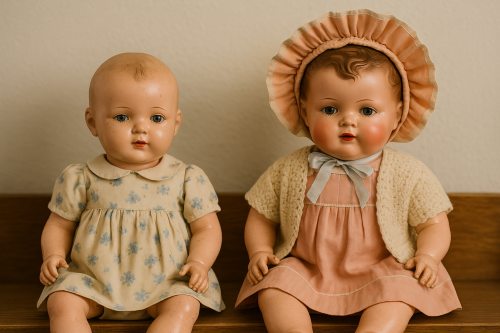
Vintage dolls carry more than age. They hold stories, emotion, and pieces of history. This article explores the beauty and meaning behind collecting them.
By Sergio Toledo
Editor-in-Chief, Heed to Heal
Introduction
To someone passing by, a vintage doll might seem like nothing more than an old toy. But to a collector, a doll can hold far more than molded features and worn fabric. It can carry memory, comfort, and even pieces of the past. Whether they come from the 1960s, 1970s, or decades earlier, vintage dolls often hold stories that live in the details — a hand-stitched dress, a cracked paint finish, or the slight tilt of a porcelain face.
Collecting vintage dolls is not just a hobby. For many, it is a quiet way of connecting with something deeper. There is a certain kind of stillness and reverence that comes with holding a doll that has seen time pass. In that moment, you are not just holding a figure. You are holding what it may have meant to someone else, and what it now means to you.
These dolls do not need to speak to tell their stories. Their history lives in their wear, their craftsmanship, and the way they’ve survived across generations. When someone loves vintage dolls, they are often loving more than the object. They are loving a piece of history, emotion, and personal reflection.
Dolls as Echoes of Time and Culture
Each vintage doll reflects the era it was created in. The hairstyles, clothing, and materials used all speak to the culture and values of that time. Dolls from the 60s may wear mod-inspired outfits. Dolls from the 1930s may carry a more somber expression or wear muted tones that reflected the world they were made in. These choices were not random. They were tiny snapshots of the larger world.
When collectors care for these dolls, they are preserving more than just items. They are preserving fashion, art, and the ways childhood once looked and felt. These dolls remind us of how quickly the world changes, and how important it is to hold onto what grounds us. Even a single doll can represent decades of design, storytelling, and emotional memory.
Composition dolls, in particular, carry a unique kind of history. Made of a mix of sawdust and glue, they were popular in the early to mid-1900s before plastic became the standard. Their soft, painted faces and slightly fragile nature give them a kind of quiet vulnerability. To hold a composition doll is to hold a piece of a very specific moment in time — one that still speaks through the wear in the paint or the cracks in the surface.
There is also something comforting about holding history in your hands. In a world that moves fast, vintage dolls offer a pause. They remind us of a slower pace, where objects were made with intention and childhood felt more tactile. For collectors, these echoes of time create a quiet connection across generations.
The Emotional Bond between Collector and Doll
It is not unusual to feel emotionally attached to a doll, especially one with age and history. Sometimes it reminds us of someone we knew. Sometimes it reflects a part of ourselves we want to care for. The bond is personal and hard to explain to those who do not feel it. But for collectors, it makes perfect sense.
Many people who collect dolls find that certain ones speak to them. A cracked porcelain face or a slightly tilted eye might not be “perfect,” but it feels familiar. It holds character. That doll becomes more than part of a collection. It becomes part of a personal story. In some cases, collectors even assign personality or emotion to the dolls they care for.
Here are a few reasons people feel so connected to vintage dolls:
- They remind us of childhood and what it felt like to be cared for
- They represent patience, detail, and intentional beauty
- They allow space for nostalgia and emotional reflection
- They bring comfort during times of stress or change
- They offer a quiet form of creativity and expression
This connection is not childish or silly. It is deeply human. Collecting dolls is not about escaping reality. It is about creating small spaces of meaning and tenderness in a world that can feel cold or rushed.
Caring for History with Gentle Hands
Collectors know that caring for vintage dolls is more than dusting off shelves. It is a form of respect. Each doll that enters a collection becomes part of a quiet ritual — the soft brushing of hair, the careful positioning of limbs, the choice of where it will be placed. These acts are small, but they carry weight.
Restoring an old doll can feel like giving something lost a second life. It is not always about making it look new. Sometimes, it is about honoring the flaws. A doll with a scuffed shoe or a faded ribbon is not broken. It is real. And for the person who finds it, that worn look might be exactly what makes it beautiful.
The world often moves quickly past old things. But collectors know that value does not always lie in what is newest or most pristine. Sometimes it lies in what has lasted — and in the hands of someone who still sees its worth.
References
- Stewart, R. (2016). Collecting Dolls: A Journey Through Time.
- American Doll Collectors Association. (2022). “Vintage Dolls and Their Cultural History.”
- Emotional Object Studies Quarterly. (2019). “The Attachment to Sentimental Objects.”
- DollKind Magazine. (2021). “Why We Collect: The Emotional Side of Dollkeeping.”
Originally published by Heed to Heal, 09.18.2025, under the terms of a Creative Commons Attribution-NonCommercial-NoDerivatives 4.0 International license.





